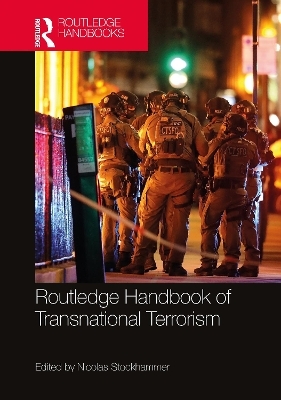
Routledge Handbook of Transnational Terrorism
Routledge (Verlag)
978-1-032-35319-7 (ISBN)
This handbook provides contributions by some of the world-leading experts in the field on recent phenomena and trends in transnational terrorism.
Based on the methodological approach of a trend-and-key factor analysis of transnational terrorism and processed on the virtual platform "Foresight Strategy Cockpit" (FSC), the volume seeks to examine what potential future variants of transnational terrorism may evolve. Focusing on the latest structural developments in the sphere of politically or religiously motivated violence, the handbook considers the tactical, strategic, and not least the systemic dimension of terrorism. Divided into seven thematic sections, the handbook’s contributions cover a wide range of issues, dealing among others with strategic and hybrid terrorism, the systemic dimension of extremist violence, prevalent actors, counter-narratives, the crime terror-nexus, the role of digitalization and the spiral dynamic between Islamist and right-wing terrorism. The expert contributions provide a condensed overview of current developments, structural linkages and important academic debates centering around transnational salafi-jihadi terrorism, but also right-wing terrorism and counter-terrorism. A key objective of the work is to make the effects of prevention/preemption, (de-) radicalization and (non-) intervention both transparent and assessable. As such, it contributes well-founded strategies, feasible solutions and options for policy-makers and counter-terrorism experts.
This volume will be of great interest to students of terrorism and counter-terrorism, political violence and security studies.
Nicolas Stockhammer is Director of the Research Cluster “Counter-Terrorism, CVE (Countering Violent Extremism) and Intelligence” at Danube-University Krems (Austria).
1. Introduction PART I The Strategic and Systemic Dimension of Terrorism 2. Strategic Terrorism 3. Geopolitical Game Changers and their Impact on Global Terrorism 4. The Systemic Dimension of Jihadist Violence: A Root Cause Analysis of Jihadist Terrorism 5. Jihadist Violence: New Terrorist Actors/Groups Emerging - Who Will be the Key Players in the Next Decade? 6. From Networks to Social Identity: A Dialectical Model of Terrorism 7. The Atomization of Political Violence 8. The Case of Hybrid Terrorism–Systemic Lessons from recent European Plots PART II Technology and Radicalization 9. The Emerging Terrorist Technological Landscape 10. Online Territories of Terror: The Multi-Platform Communication Paradigm and the Information Ecology of the Web3 Era 11. The Virtualization of Terror: Violent Extremism on the Internet Today 12. The Evolution of Hybrid Radicalization: From Small Group to Mass Phenomenon 13. The Emergence of Decoupled Radicalization and Franchise Terrorist: McJIHAD 14. The Crime-Terror-Nexus in Europe and its Implication for Jihadist radicalization 15. Counter-Narratives Part III Right-Wing Extremism and Stochastic Terrorism 16. Ideological Polarization and Societal Disruption 17. The Current and Future Threat Posed by Islamist and Right-Wing Extremist Terrorism in Europe 18. Generation Z and Terrorism 19. Stochastic Terrorism: Mass Media Escalation Against Victim Groups as a Radicalization Platform for Terrorist Individual Perpetrators? 20. The Heightened Threat of U.S. Domestic Terrorism 21. Right-wing Extremists and State Deniers in Europe: Current Narratives, Trends and Actors PART IV Forecast, Trends, Scenarios and Tactics 22. How to Forecast and Predict Future Terrorist Warfare 23. Recent Trends in International Terrorism and Their Impact on CT Ambitions 24. Key Trends in Transnational Terrorism: A Software based Key Factor Foresight Analysis 25. Scenarios of Transnational Terrorism: Trends and Developments - A Fact-Based Threat Assessment 26. Foiled versus Launched Terror Plots: Some Lessons Learned 27. Hybrid Loans and Tactics of Jihadism: Will Hybridity Remain the Narrative of Convergent, Politically Motivated Violence? 28. Terrorism and Hybrid Threats: Analyzing Common Characteristics and Constraints for Counter-Measures PART V Political Islam, Jihadism, Psychology and Counter-Terrorism 29. Legalistic Islam: The Transition from Political Islam to Jihadism 30. Jihadism and True Islam: Discourses and Realities 31. Jihadism in the West: A Post-Caliphate Transitory Phase 32. Becoming a Jihadist: A Psychoanalytical Perspective 33. Understanding the Motivation of "Lone-Wolf" Terrorists: The "Bathtub" Model 34. Evolving Perspectives on Psychopathology and Terrorism 35. European Approaches to Risk Assessment of Terrorist Offenders 36. A Model for Countering Violent Extremism and Promoting Disengagement from Terrorism PART VI Covid-19, Resilience and Terrorism 37. Crises and Catastrophes, Security and Resilience: On the Significance of Finding Definitions for Security Policy 38. Covid-19 and Global Terrorism Pandemics 39. The False Promise of Salafi-Jihadist: Rhetoric and the Response to Covid-19 40. The Impact of the Covid-19 Pandemic on Terrorism and Counter-Terrorism: Reassessing the Evidence 41. A Legacy of Disorder, Desperation and Defiance: The Possible Effects of the Coronavirus Pandemic on the Future Course of Terrorism 42. Hybrid Jihad: A Trend Scenario for Transnational Terrorism 43.Terrorist Threats Post Covid-19 PART VII Afghanistan, Al-Qaeda and Beyond 44. The Security Situation in Afghanistan and the Implications for Global Terrorism 45. Afghanistan under Taliban Rule: Consequences for Global Security and Terrorism Against the West 46. Afghanistan after the Withdrawal of the West: The Taliban, al-Qaeda, and IS- K 47. Global Jihad: Al-Qaeda and the Islamic State’s Struggle for Power and Global Dominance 48. Al-Qaeda - 20 years after 9/11 49. The Taliban-al-Qaeda Nexus: Brothers in Arms
| Erscheinungsdatum | 22.08.2023 |
|---|---|
| Zusatzinfo | 3 Tables, black and white; 23 Line drawings, black and white; 23 Illustrations, black and white |
| Verlagsort | London |
| Sprache | englisch |
| Maße | 174 x 246 mm |
| Gewicht | 1240 g |
| Themenwelt | Geisteswissenschaften ► Psychologie ► Allgemeine Psychologie |
| Sozialwissenschaften ► Politik / Verwaltung ► Europäische / Internationale Politik | |
| Sozialwissenschaften ► Soziologie ► Empirische Sozialforschung | |
| ISBN-10 | 1-032-35319-8 / 1032353198 |
| ISBN-13 | 978-1-032-35319-7 / 9781032353197 |
| Zustand | Neuware |
| Haben Sie eine Frage zum Produkt? |
aus dem Bereich


